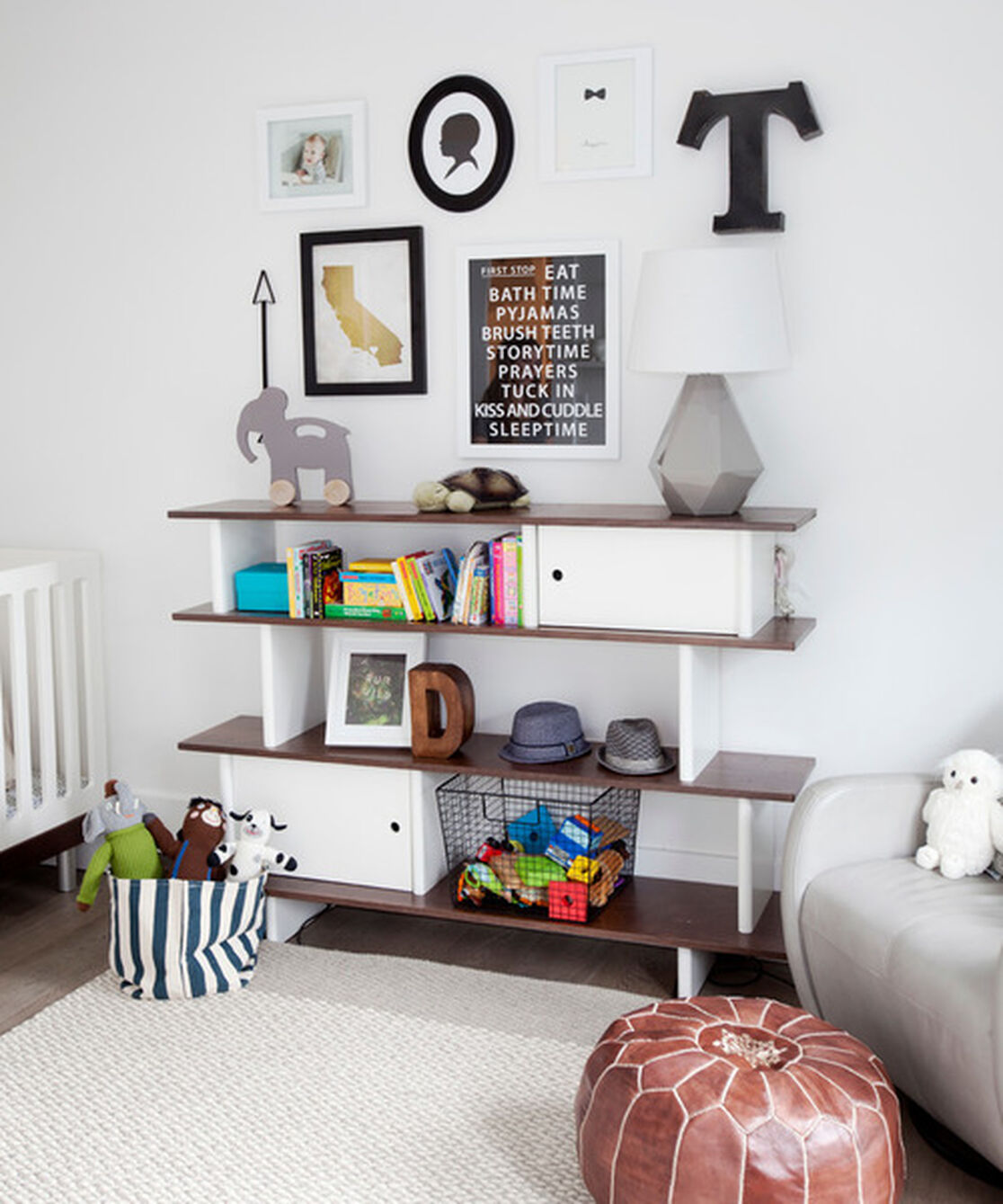Keep clutter under control with these space-saving storage and baby-gear ideas, courtesy of our friends at Houzz.
Living in a small space is challenging enough as it is — add a baby into the mix, and even those who thought they had their space all figured out can be thrown for a loop. Between the tiny clothes, toys and books and the big stuff, like strollers, swings and gear, figuring out where everything can go is like playing a giant game of Tetris … but sleep-deprived and with a small person attached to your side. Here are for 15 tips to help you choose the right baby gear, pare down what you have and squeeze every last possible inch out of your home.
[caption id="attachment_21286" align="aligncenter" width="500"] The Cross Interior Design[/caption]
1. Pack away all toys, clothes and gear that baby is not ready for yet. Babies grow so fast that it’s natural to accumulate clothes and gear your little one is not quite big enough for yet — but that doesn’t mean those items need to be accessible right now.
Keep only what you are using daily right now on the easiest-to-reach shelves, and stow the rest out of the way. Under bed boxes and high shelves over doorways or in closets are great places for this. Clearly label the stowed stuff (and sort it by age if possible) to make it easy to find the next size up when you need it.
2. Choose mini-size baby gear. If you are still in the planning phase, seek out the smallest possible versions of the gear you need, from a mini bassinet that can expand as baby grows to a rocker with a small footprint.
Even if you already have all the gear, don’t feel like you have to live with something that isn’t working out. You may be able to return or exchange it at the store or through the manufacturer even after using it, and you can always sell or swap items on Craigslist.
3. Hide storage areas with ceiling-mounted curtains. Floor-to-ceiling shelving is a godsend for parents, especially when you live in a small space: It fits a ton and is super-convenient for putting things away. But storing everything on open shelving can look messy quite easily.
One simple way to get the storage benefits while still maintaining a serene feel is to hang full-length curtains from the ceiling in front of the shelving — just slide them closed, and all of that messy storage will disappear.
[caption id="attachment_21287" align="aligncenter" width="500"]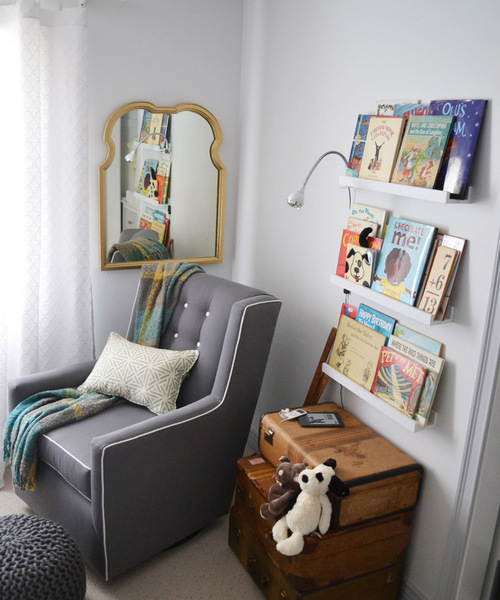 Youthful Nest[/caption]
Youthful Nest[/caption]
4. Hang picture-book shelves. Slim picture rails are the perfect size for keeping picture books neat and off the floor. Hang several tiers of these handy shelves to maximize wall space.
5. Stack suitcases as storage. Small vintage suitcases and trunks are perfect for containing clothes that baby hasn’t grown into yet.
6. Incorporate sneaky baby-stuff storage into other rooms. No matter the size of your home, when you have a baby, the baby’s stuff will end up in every room in your home. It’s the law. Don’t fight it; be smart about it: Reserve at least one shelf, cabinet or drawer in every piece of furniture in your home (save, perhaps, your own dresser) for baby stuff. By purposely tucking in a basket here, a shelf there for toys, diapers and so on, you can avoid the dreaded big pile o’ stuff that otherwise materializes in the center of the room every afternoon.
[caption id="attachment_21288" align="aligncenter" width="500"]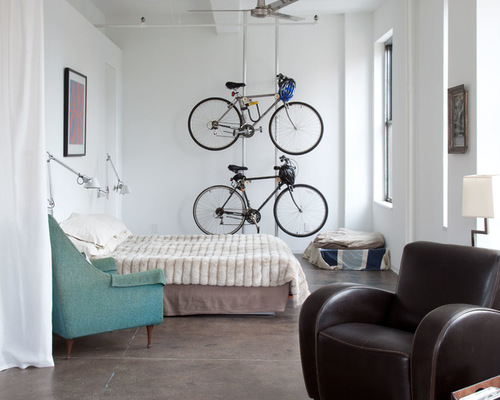 Ira Frazin Architect[/caption]
Ira Frazin Architect[/caption]
7. Steal this wall-mounted-bike trick for a stroller. I’ve never actually seen this done with baby gear (hence the picture of bikes, not strollers), but it seems like it could be an absolute lifesaver in a small apartment — especially one with no secure porch on which to store strollers.
Use sturdy wall hooks to get that big jogging stroller, or even the bouncy seat or swing, out of the way. For safety, try this out in a room where baby doesn’t hang out, like the front hall.
8. Mount toys on the wall. Rods or rails with hanging buckets, bins or soft wall pockets provide a nice spot for baby’s favorite toys. Even younger babies can appreciate a soft felt wall hanging with toys to tuck in and out of pockets. Older babies might enjoy hanging buckets filled with chalk beside a chalkboard wall.
9. Fold up and flip down. A changing table that flips down from the wall or folds out from a cabinet can be a great space saver in a small nursery. Also look for strollers that fold up to be small, and collapsible baskets and hampers. Slender lines, lightweight pieces and portability will make the best use of your space.
[caption id="attachment_21289" align="aligncenter" width="500"]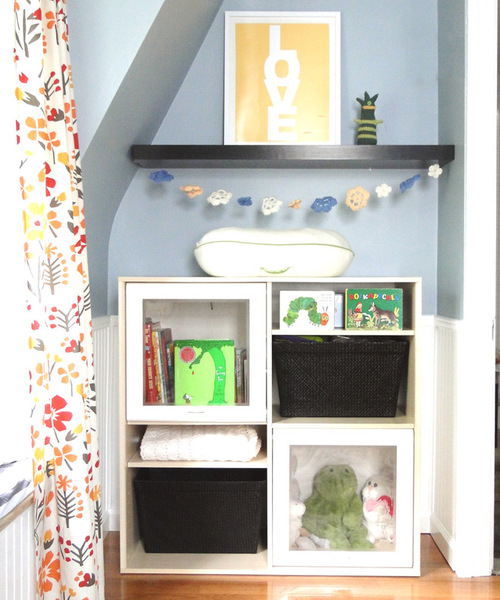 Lauren Hufnagl[/caption]
Lauren Hufnagl[/caption]
10. Fill small, awkward nooks with storage. Make it your mission to not let a single square inch go unused. Fill small nooks and tight corners with petite bookcases, wall shelves and bins. Look carefully around your space and see where you might be able to add a little extra storage.
11. Make a wall-mounted baby activity zone. Babies and toddlers experience the world through their senses, and a wall-mounted sensory exploration zone can keep little hands busy for hours … OK, not hours, but certainly for entire minutes at a time. Attach age-appropriate toys, musical instruments and sensory items like brushes with soft and rough bristles, scratchy sandpaper and soft fabric. Just be sure that anything you put within baby’s reach is securely attached and does not include any pieces small enough to choke on.
12. Transform a closet into a baby-care hub. You can fit baby’s clothes, diapers and more into a tiny space with the right planning. Tuck a small dresser topped with a changing pad into the closet and hang a short clothing rod and shelving above. Use baskets to keep things organized and easy to grab, and hang some soft pockets to keep diapering essentials within reach.
13. Choose good-looking, multipurpose gear that will last.Instead of having three strollers that serve different needs, try to settle on one that will work in most situations. A high chair that can work for your wee one through babyhood and beyond (and looks great at the table) is a better buy than something you will need to trade in after a year or two and is a giant eyesore. Be conscious about choosing gear you will need to replace after a year or two, especially if you plan to keep the older version even after buying a new one. Multiple sets of baby gear will take over your home in the blink of an eye — avoid them at all costs!
[caption id="attachment_21290" align="aligncenter" width="500"]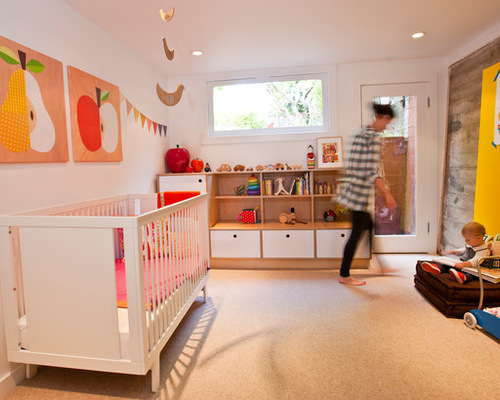 Red Princess Productions[/caption]
Red Princess Productions[/caption]
14. Use more baskets. Baskets are a new parent’s best friend. They are pretty, portable and, best of all, easy to toss things into. Put them in every single room and use them for everything: laundry, stuffed animals, books, blocks, magazines and random messes that you want to hide before company arrives.
15. Rethink your essentials. Just because it was on the list of must-haves in a baby book doesn’t mean that you must have it, and just because someone gave it to you doesn’t mean you need to keep it. Does your baby always fall asleep in the vibrating bouncer but not really care for the swing? Get rid of the swing. Trust yourself to know what you and your baby really need, and give yourself permission to get rid of things that are only cluttering up your home and driving you nuts. Hate that giant plastic sound machine (oops, I meant toy) you received as a gift? Pass it along to someone who will appreciate it. It’s time to reclaim your space.
~Christine Tusher, Houzz
Houzz is a platform for home remodeling and design, bringing homeowners and home professionals together in a uniquely visual community.
For more storage inspiration, check out these other helpful links from Houzz!
We aim to provide you with the most honest and credible information possible. This article was reviewed for accuracy by The Honest Team and was written based on sources that are linked at the bottom of the article.
blog_review_statement